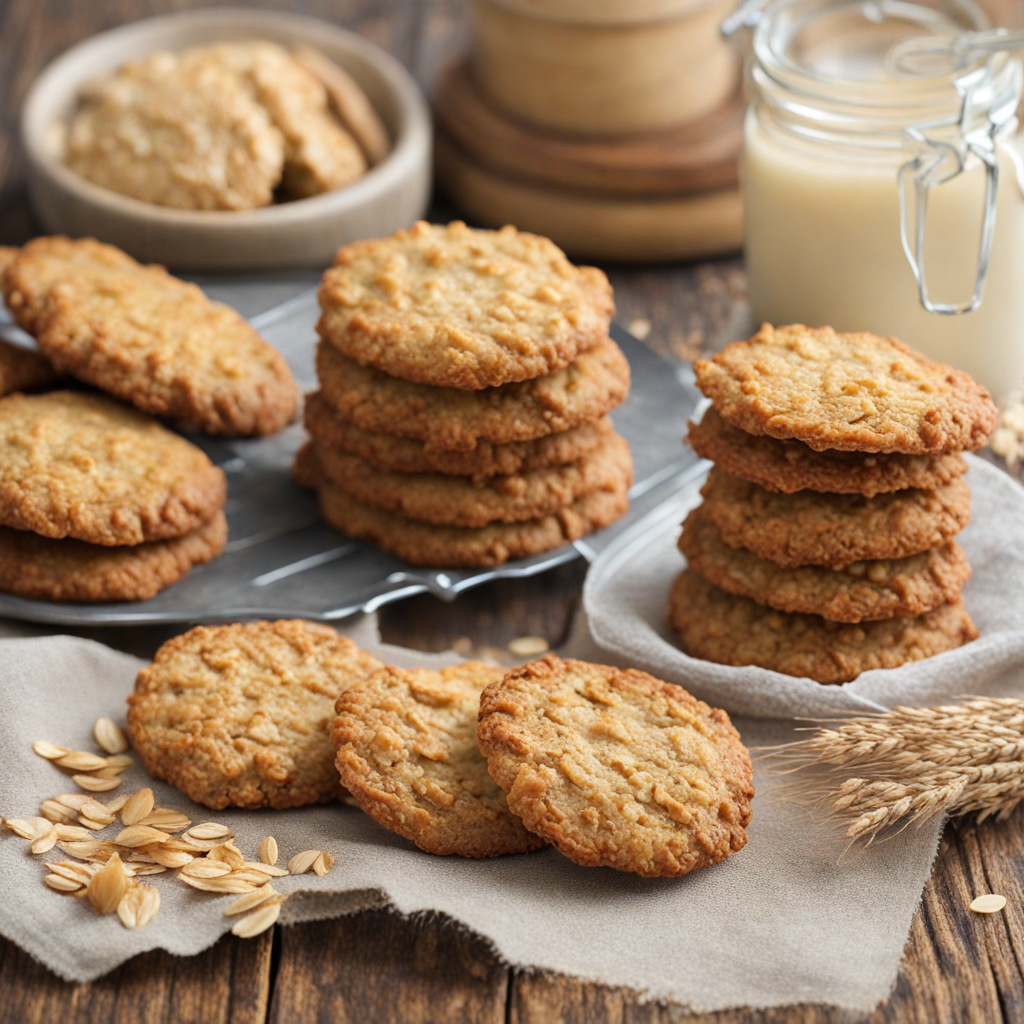Anzac Biscuit
The Anzac Biscuit is a delightful treat that captures the essence of Australian baking with its rich history and comforting flavors. Traditionally made from a simple combination of oats, flour, sugar, butter, golden syrup, baking soda, and desiccated coconut, these biscuits offer a unique blend of sweetness and a chewy texture that is irresistibly satisfying. The oats provide a hearty base, while the golden syrup adds a distinct caramel-like sweetness that perfectly complements the crunch of the coconut. Each bite delivers a warm, wholesome experience that evokes the nostalgia of homemade goodness. As you take a bite, you'll notice the delightful contrast between the crispy edges and the soft center, creating a satisfying mouthfeel. The aroma of toasted oats and coconut wafts through the air, inviting you to indulge in another piece. Anzac Biscuits are not overly sweet, making them an ideal companion for afternoon tea or a late-night snack. They also have a slight nuttiness from the oats, which pairs beautifully with a cup of tea or coffee, enhancing the overall tasting experience. Beyond their delicious flavor, Anzac Biscuits carry a significant historical context, traditionally baked to send to soldiers during World War I due to their long shelf life. This connection infuses each biscuit with a sense of heritage, making them more than just a treat—it's a bite of history. Whether enjoyed at home or shared with friends, Anzac Biscuits are a delightful way to explore Australian culture through its culinary offerings, leaving you with a newfound appreciation for this iconic biscuit.
How It Became This Dish
The Anzac Biscuit: A Taste of History The Anzac biscuit, a beloved treat in Australia and New Zealand, is not just a delicious confection; it is a symbol steeped in history and national pride. Its origins trace back to World War I, during a time of immense upheaval and sacrifice, and its cultural significance has evolved over the decades, making it an integral part of the culinary landscape in both nations. #### Origins and Historical Context The term "ANZAC" stands for the Australian and New Zealand Army Corps, formed during World War I. The soldiers of ANZAC were known for their bravery and camaraderie, particularly during the ill-fated Gallipoli campaign in 1915, which became a defining moment in the national consciousness of both Australia and New Zealand. The campaign was marked by heavy casualties and extreme hardship, yet it also fostered a sense of unity and identity among the troops and their home countries. As families and communities rallied to support the war effort, they sought ways to send provisions to their soldiers. The Anzac biscuit was created as a durable and nutritious food item that could withstand the long journey to the front lines. Made primarily from oats, flour, sugar, butter, golden syrup, baking soda, and desiccated coconut, the ingredients were chosen for their non-perishable qualities. The biscuits were easy to prepare, could be shipped without spoiling, and provided soldiers with much-needed sustenance. #### The First Recipe The earliest known recipes for Anzac biscuits appeared in Australian newspapers in the early 1910s, particularly in the context of fundraising efforts for the war. One of the first published mentions can be found in the "War Cookery Book," a 1917 compilation that provided recipes designed for wartime rations. These recipes emphasized the use of simple, readily available ingredients, reflecting the resourcefulness of Australian homemakers during the war. Interestingly, the Anzac biscuit is not a traditional biscuit in the British sense; it is more akin to what Americans would refer to as a cookie. The texture is chewy and hearty, with a rich, caramel-like flavor due to the golden syrup. Over time, variations emerged, incorporating chocolate chips, nuts, and even dried fruits, but the core recipe has remained largely intact. #### Cultural Significance The Anzac biscuit transcends mere sustenance; it embodies the spirit of sacrifice, resilience, and mateship that characterizes the ANZAC legacy. As the war ended and remembrance of the ANZACs grew, so too did the popularity of the biscuit. Today, Anzac Day, observed on April 25th in both Australia and New Zealand, commemorates the soldiers who served and died in all wars. The biscuit has become a central part of the observance, often baked in homes and shared in remembrance of those who fought. The act of baking and sharing Anzac biscuits has evolved into a ritual that reinforces community bonds and national identity. Schools and organizations frequently host baking events, where the biscuits are prepared and shared, fostering a sense of togetherness and respect for the ANZACs' sacrifices. #### Legal Protection and Modern Variations In the 1980s, the significance of the Anzac biscuit prompted the Australian government to impose regulations on its use. The term "Anzac" has been protected under the ANZAC Regulations, which prohibit the use of the name for commercial purposes without permission. This legal framework ensures that the biscuit retains its historical and cultural integrity and is not exploited for profit. Despite this protection, the Anzac biscuit has seen numerous adaptations over the years. It has been embraced in cafes and bakeries across Australia and New Zealand, with variations that cater to modern dietary preferences, including gluten-free and vegan options. However, traditional recipes remain a staple, often passed down through generations, preserving the connection to the past. #### The Anzac Biscuit Today In contemporary Australia and New Zealand, the Anzac biscuit is more than just a nostalgic treat; it represents a shared history and collective memory. It is often included in care packages sent to soldiers serving overseas, reminding them of home and the sacrifices made by those who came before them. The biscuits have also gained international recognition, appearing in various culinary contexts and inspiring similar recipes around the world. In recent years, the Anzac biscuit has found its way into popular culture, featuring in cookbooks, television cooking shows, and even social media platforms. This visibility has contributed to a broader understanding of the ANZAC legacy, sparking interest among younger generations who may not have a direct connection to the events of World War I. #### Conclusion The Anzac biscuit is a poignant reminder of the courage and resilience of the ANZAC soldiers and the communities that supported them. From its humble beginnings as a practical wartime food to its status as a cherished symbol of national identity, the biscuit encapsulates the spirit of a nation. As Australians and New Zealanders continue to bake and share Anzac biscuits, they partake in a longstanding tradition that honors the past while fostering a sense of unity and remembrance for future generations. This simple yet profound confection serves as a delectable bridge between history and modern life, ensuring that the sacrifices of the ANZACs are never forgotten. Whether enjoyed with a cup of tea or shared during solemn commemorations, the Anzac biscuit remains a delicious testament to a significant chapter in the history of Australia and New Zealand.
You may like
Discover local flavors from Australia







